This document discusses green communication and summarizes several research papers on the topic. It outlines the objectives of green communication as protecting the environment from harmful EM radiation, reducing greenhouse gases, and reducing wireless network operational costs. It then summarizes several papers on topics like power control, resource allocation, power allocation, and massive MIMO. The document also discusses energy consumption in the ICT industry, wireless resource trading challenges, and open research areas in green communication like massive MIMO and cooperative communication. It presents two case studies analyzing the energy efficiency of massive MIMO systems with considerations for aspects like channel gain, number of antennas, and transceiver power consumption.
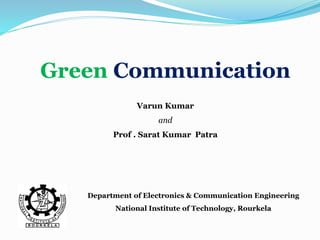
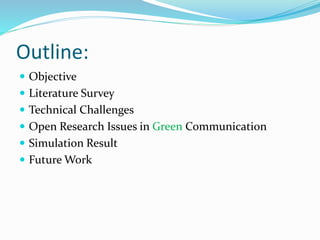

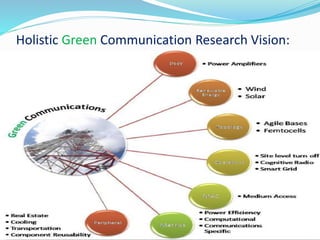






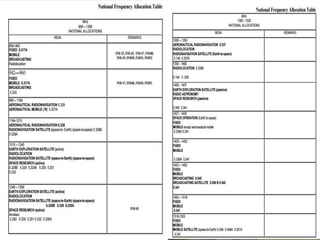









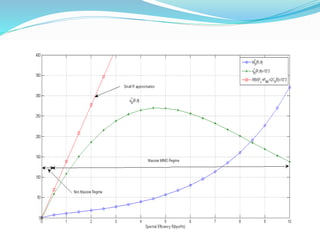
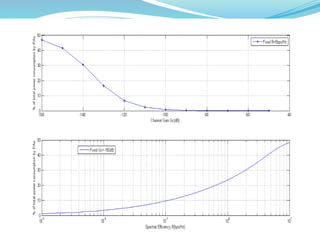





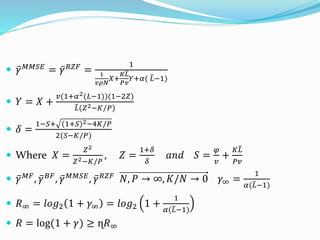




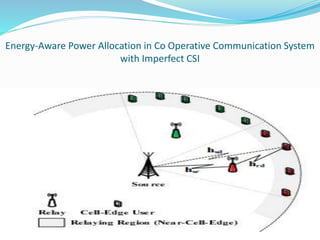



![Optimal transmit powers for the source and relay to maximize the
SNR when channel estimation errors are present
𝑃𝑠2
∗
=
ѱ4[ ѱ2+1 𝑃 𝑇+ѱ3]𝑃 𝑇
ѱ3[ ѱ1+1 𝑃 𝑇+ѱ3]+ ѱ4[ ѱ2+1 𝑃 𝑇+ѱ3]
𝑃𝑟2
∗
=
ѱ3[ ѱ1+1 𝑃 𝑇+ѱ4]𝑃 𝑇
ѱ3[ ѱ1+1 𝑃 𝑇+ѱ3]+ ѱ4[ ѱ2+1 𝑃 𝑇+ѱ3]](https://image.slidesharecdn.com/3ee677d0-d85b-454d-9101-190ead75d9ef-160107052106/85/Green-Communication-37-320.jpg)



![References:
[1] A. Goldsmith, Wireless communications, Cambridge university press, 2005.
[2] L. Zheng and D. N. Tse, "Diversity and multiplexing: a fundamental tradeoff in multiple-antenna
channels," Information Theory, IEEE Transactions on, vol. 49, no. 5, pp. 1073-1096, 2003.
[3] R. Zhang, L. Wang, G. Parr, O. G. Aliu, B. Awoseyila, N. Azarmi, S. Bhatti, E. Bodanese, H. Chen, M.
Dianati and others, "Advances in base-and mobile-station aided cooperative wireless
communications: An overview," Vehicular Technology Magazine, IEEE, vol. 8, no. 1, pp. 57-69,
2013.
[4] L. Wang and L. Hanzo, "Optimum time resource allocation for TDMA-based differential decode-
and-forward cooperative systems: a capacity perspective," Communications Letters, IEEE, vol. 14,
no. 6, pp. 506-508, 2010.
[5] S. Mukherjee and S. K. Mohammed, "Energy-Spectral Efficiency Trade-off for a Massive SU-MIMO
System with Transceiver Power Consumption," arXiv preprint arXiv:1410.5240, 2014.
[6] S. Mallick, R. Devarajan, M. M. Rashid and V. K. Bhargava, "Robust power allocation designs for
cognitive radio networks with cooperative relays," in Communications (ICC), 2012 IEEE
International Conference on, 2012.
[7] L. Lu, G. Y. Li, A. L. Swindlehurst, A. Ashikhmin and R. Zhang, "An overview of massive MIMO:
benefits and challenges," Selected Topics in Signal Processing, IEEE Journal of, vol. 8, no. 5, pp.
742-758, 2014.
[8] W. Liu, S. Han, C. Yang and C. Sun, "Massive MIMO or small cell network: Who is more energy
efficient?," in Wireless Communications and Networking Conference Workshops (WCNCW), 2013
IEEE, 2013.](https://image.slidesharecdn.com/3ee677d0-d85b-454d-9101-190ead75d9ef-160107052106/85/Green-Communication-41-320.jpg)
![[9] J. Hoydis, S. Ten Brink and M. Debbah, "Massive MIMO in the UL/DL of cellular networks: How
many antennas do we need?," Selected Areas in Communications, IEEE Journal on, vol. 31, no. 2,
pp. 160-171, 2013.
[10] A. J. Fehske, P. Marsch and G. P. Fettweis, "Bit per joule efficiency of cooperating base stations
in cellular networks," in GLOBECOM Workshops (GC Wkshps), 2010 IEEE, 2010.
[11] R. Devarajan, S. C. Jha, U. Phuyal and V. K. Bhargava, "Energy-aware resource allocation for
cooperative cellular network using multi-objective optimization approach," Wireless
Communications, IEEE Transactions on, vol. 11, no. 5, pp. 1797-1807, 2012.
[12] R. Devarajan, A. Punchihewa and V. K. Bhargava, "Energy-aware power allocation in cooperative
communication systems with imperfect CSI," Communications, IEEE Transactions on, vol. 61, no.
5, pp. 1633-1639, 2013.
[13] M. Chiang, C. W. Tan, D. P. Palomar, D. O'Neill and D. Julian, "Power control by geometric
programming," Wireless Communications, IEEE Transactions on, vol. 6, no. 7, pp. 2640-2651,
2007.
[14] S. Bu, F. R. Yu, Y. Cai and X. P. Liu, "When the smart grid meets energy-efficient
communications: Green wireless cellular networks powered by the smart grid," Wireless
Communications, IEEE Transactions on, vol. 11, no. 8, pp. 3014-3024, 2012.
[15] R. Berry, R. G. Gallager and others, "Communication over fading channels with delay
constraints," Information Theory, IEEE Transactions on, vol. 48, no. 5, pp. 1135-1149, 2002.](https://image.slidesharecdn.com/3ee677d0-d85b-454d-9101-190ead75d9ef-160107052106/85/Green-Communication-42-320.jpg)
